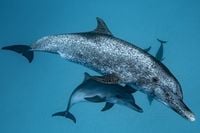In a groundbreaking effort to decode dolphin communication, Google DeepMind has unveiled a large language model (LLM) named DolphinGemma, designed specifically to interpret the vocalizations of these intelligent marine mammals. This innovative model is set to revolutionize how researchers understand the complex sounds produced by dolphins, particularly those belonging to the Atlantic spotted dolphin species.
Since its inception in 1985, the Wild Dolphin Project (WDP) has been at the forefront of studying wild Atlantic spotted dolphins in the Bahamas, analyzing generations of these creatures to uncover the intricacies of their communication. Now, with the aid of DolphinGemma, researchers are on the cusp of potentially deciphering the whistles, clicks, and chirps that characterize dolphin interactions.
According to Google, DolphinGemma was trained using an extensive library of acoustic data collected by the WDP. This data includes various dolphin sounds linked to specific behaviors, such as mothers calling their calves using distinct signature whistles, which serve as unique names. Denise Herzing, the founder and head of research at WDP, expressed her excitement about this advancement, stating, “I’ve been waiting for this for 40 years.”
The model’s capabilities allow it to create sound sequences that mimic those produced by dolphins, offering researchers a powerful tool for exploring previously hidden structures and potential meanings within dolphin communication. By identifying recurring sound patterns, DolphinGemma aims to help scientists uncover the rules governing dolphin vocalizations.
WDP researchers will utilize a specialized underwater system known as CHAT (Cetacean Hearing Augmentation Telemetry), which will be equipped with a Google Pixel 9 smartphone running DolphinGemma. This system is designed to recognize, record, and reproduce individual dolphin sound patterns, enabling researchers to interact with the dolphins in real time.
As the WDP continues its long-term study of dolphin behavior, the integration of DolphinGemma is expected to enhance their understanding of dolphin communication. The ultimate goal is for the A.I. system to predict subsequent sounds in a sequence of dolphin vocalizations, similar to how other LLMs predict the next word in human language. This predictive capability could provide insights into the meanings behind various dolphin sounds, which have remained largely indecipherable to humans.
Moreover, DolphinGemma is not only about understanding existing dolphin sounds; it also has the potential to contribute new sounds to dolphin communication. The CHAT system, a collaborative project between WDP and the Georgia Institute of Technology, aims to teach dolphins to mimic novel whistles associated with objects they enjoy, such as seagrass or scarves. By emitting specific whistles while passing these objects to one another, researchers hope to encourage dolphins to request these items using new sounds.
Google’s A.I. model could significantly aid CHAT in identifying these mimics at a faster rate, potentially expanding the repertoire of sounds dolphins use to communicate. Although DolphinGemma was initially trained on data from Atlantic spotted dolphins, Google believes its applications could extend to other dolphin species, such as bottlenose or spinner dolphins.
In a further commitment to advancing cetacean research, Google plans to share DolphinGemma as an open model with other researchers this summer, fostering collaboration and innovation in the field of marine biology. Herzing emphasized the importance of this work, noting that language remains “the last barrier” in understanding dolphins. “The goal would be for somebody to speak dolphin, and we’re really trying to crack the code,” she said.
The deployment of DolphinGemma is anticipated to coincide with WDP’s upcoming field season, marking a significant milestone in the quest to decode dolphin communication. As researchers prepare to take to the seas, the excitement surrounding this initiative is palpable, with many hoping that the insights gained from this project will not only enhance our understanding of dolphin language but also foster a deeper connection between humans and these remarkable creatures.
In conclusion, the collaboration between Google DeepMind and the Wild Dolphin Project represents a significant leap forward in marine research. With the capabilities of DolphinGemma, researchers are poised to unlock the mysteries of dolphin communication, paving the way for new discoveries that could reshape our understanding of these intelligent beings.

